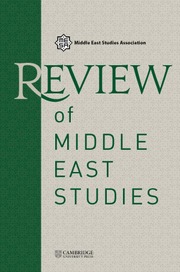No CrossRef data available.
Article contents
Crafting a Post-Conflict Constitution for Yemen: Navigating Rule of Law and Emerging Forces
Published online by Cambridge University Press: 25 August 2025
Abstract
This article explores the challenges of drafting a post-conflict constitution for Yemen, with a focus on balancing the rule of law with emerging political forces, particularly in the context of the country’s ongoing civil war. It highlights the importance of inclusivity, adaptability, and public participation in creating a constitution that promotes peace and stability. Drawing on lessons from Yemen’s recent history and the broader Middle East, the study emphasizes the role of conflict dynamics, particularly those involving the Houthi movement and the Southern Transitional Council, and the implications of separatist aspirations for a unified Yemen. The analysis offers pathways for addressing transitional justice, reconciliation, and the failures of Yemen’s previous constitutional transition, and for laying a foundation for long-term peace and prosperity.
Information
- Type
- Special Focus Roundtable: Constitutional Change and the Rule of Law
- Information
- Copyright
- © The Author(s), 2025. Published by Cambridge University Press on behalf of Middle East Studies Association of North America
References
1 Nadia Al-Sakkaf, “Yemeni Women’s Involvement, Representation, and Influence in Political Parties and Components,” paper commissioned by the Office of the Special Envoy of the Secretary-General for Yemen, 2022, https://www.academia.edu/74524630/Yemeni_womens_involvement_representation_and_influence_in_political_parties_and_components.
2 Erica Gaston, “Process Lessons Learned in Yemen’s National Dialogue,” special report, US Institute of Peace, 2014, https://www.usip.org/sites/default/files/SR342_Process-Lessons-Learned-in-Yemens-National-Dialogue.pdf; Maysaa Shuja Al-Deen, “Yemen’s Houthis and Former President Saleh: An Alliance of Animosity,” Arab Reform Initiative, 2016, https://www.arab-reform.net/publication/yemens-houthis-and-former-president-saleh-an-alliance-of-animosity.
3 Anderson, George, “Yemen’s Failed Constitutional Transition,” in Territory and Power in Constitutional Transitions, ed. Anderson, George and Choudhry, Sujit (Oxford, 2019)Google Scholar, https://doi.org/10.1093/oso/9780198836544.003.0017.
4 Cameron Glenn, “Who Are Yemen’s Houthis?” Wilson Center, 2022, https://www.wilsoncenter.org/article/who-are-yemens-houthis.
5 See, for example, Bell, Christine, On the Law of Peace: Peace Agreements and the Lex Pacificatoria (Oxford University Press, 2008)CrossRefGoogle Scholar; and Arato, Andres, Constitution Making under Occupation: The Politics of Imposed Revolution in Iraq (New York: Columbia University Press, 2009)CrossRefGoogle Scholar.
6 Peter Salisbury, “Yemen’s Southern Transitional Council: A Delicate Balancing Act,” International Crisis Group, 2021, https://www.crisisgroup.org/middle-east-north-africa/gulf-and-arabian-peninsula/yemen/yemens-southern-transitional-council-delicate-balancing-act.
7 Galligan, Denis J. and Versteeg, Mila, eds., Social and Political Foundations of Constitutions (Cambridge University Press, 2013).CrossRefGoogle Scholar
8 Brown, Nathan J., Constitutions in a Nonconstitutional World: Arab Basic Laws and the Prospects for Accountable Government (Albany, NY: State University of New York Press, 2002).CrossRefGoogle Scholar
9 Ibid., xiv.
10 Mujais, Ayat, “The Dos and Don’ts of Federal Constitutions: A Case Study on Yemen,” American University International Law Review 33, no. 1 (2017): 287–309.Google Scholar
11 Ibid., 301.
12 Dina Hadad, “Constitutional Reform in Syria: More of the Same,” Review of Middle East Studies, this issue.
13 Maddox, Ian, “South Africa’s Dormant Emergency Clause and the Value of an Emergency Constitution,” New York International Law Review 35, no. 2 (2022): 31–52.Google Scholar
14 Manasyan, Anahit Artyomi, Constitutional Stability As an Important Prerequisite for Stable Democracy (Yerevan Hayrapet, 2020).Google Scholar
15 Callais, Justin and Young, Andrew T., “Does Rigidity Matter? Constitutional Entrenchment and Growth,” European Journal of Law and Economics 53, no. 1 (2022): 27–62.CrossRefGoogle Scholar
16 Seyed Masoud Noori, “Self-Destructive Constitutions: The Dilemma of Constitutional Stability and Adaptability; Iran’s 1906 and 1979 Constitutions, a Case Study,” Review of Middle East Studies, this issue.
17 Selin Bengi Gümrükçü, “Rule of Law Backsliding and Abusive Constitutionalism in Turkey,” Review of Middle East Studies, this issue.
18 Yash Pal Ghai and Jill Cotterll Ghai, Kenya’s Constitution: An Instrument for Change, 2nd ed., Katiba Institute, 2021, https://katibainstitute.org/wp-content/uploads/2021/08/Kenyas-Constitution-Instrument-for-Change.pdf.


